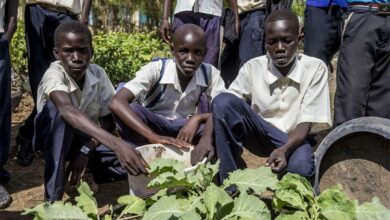Biodiversity Conservation and Sustainable Natural Resource Management (BIOCOM)

The protected natural ecosystems of these areas reduce greenhouse gas (GHG) emissions through carbon storage and capture. Thus, it offers a buffer against extreme events. These protected areas help people adapt to the effects of climate change by preserving the essential environmental services they depend upon. Also, these sites are a source of income for communities through micro-projects and conservation and ecotourism activities.
However, these values are under threat from anthropogenic influences including slash and burn agriculture, clearing for pastures, intensive bushmeat hunting, small scale or illegal logging of rose hood and illegal mining. Greenhouse gas emissions are generated predominantly by the conversion of forests to agricultural lands using slash and burn techniques and the increasing rates of forest conversion are a significant threat to the biodiversity, the carbon stockage function of the forest and the viability of downstream watershed services in Marojejy, Andohahela and Montagne des Français that vital to local and regional economies. The area’s natural resources and its 300,000 rural, poor, local human population are also highly vulnerable to climate change. Severe cyclone activity and flooding results in destroying forests and crops and causes severe soil loss on erosion prone hillsides. Increased variability in annual rainfall affects household subsistence agricultural practices and increases dependence on natural resources found within the forest landscape.
These pressures, such as illegal logging and poaching, threaten the integrity of these sites and which led to the sites’ inscription on the UNESCO List of World Heritage in Danger in 2009. Madagascar is experiencing recurrent political instability, which has led to impoverishment and dependence of the population on natural resources as well as growing insecurity and generalized poor governance. All of this has a negative impact on the World Heritage property and is a major challenge to its sustainability.
This project will contribute to the sustainability of the property through actions involving local communities, managers and local management authorities. The establishment of local “dina” contracts with local communities facilitates the management of conflicts and offenses. Accompanying measures, including the creation of income-generating activities or livelihood activities can lead to financial self-sufficiency and the reduction of dependence on natural resources. All of these fits into a broad context of sustainable development that takes into account the importance of ecological services provided by ecosystems within the World Heritage property. This complementarity of conservation and development remains a major challenge for a poor country.
On the development plan, primary schools have teachers, but programs deserve additions to develop education for sustainable development. Lastly, dropouts are frequent in primary and secondary schools, whereas vocational training centers are non-existent in the area. Women are the most disadvantaged and do not always benefit from the opportunities generated by the presence of these sites.



